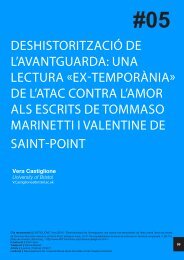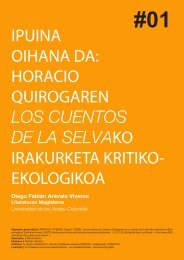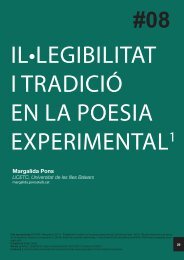scenario that takes place elsewhere, in Africa. As a famous quotementioned by Gaston Darboux reveals, Abadia had an anthropologicaland colonial understanding of the Basques: «Nous autres Basques,nous sommes un secret, nous ne ressemblons pas aux autrespeuples, fiers de leurs origines et pleins de traditions nationales. Sinous avons un fondateur, un premier aïeul, c’est Adam» (1908: xxxvi).Abadia’s colonial articulation of the Basque Country, although influential,did not take place in a vacuum. As Jon Juaristi states, in the aftermathof the first Carlist War (1833-1839) and throughout the 19th century,the most attractive element of the Basque Country was its “Arcadian”character, i.e. its colonial and yet domestic-internal character. Thisled to the creation of a Basque touristic economy, which was centraltill industrialization began in Bizkaia and Gipuzkoa in the 1890s:El País Vasco se convirtió así en la utopía de la España conservadora.La burguesía isabelina descubrió Vasconia como una tierra de paisajesverdes y costumbres patriarcales, muy adecuada para pasar elverano... Los vascos, que, como he dicho, habitaban un país pobre enrecursos, intuyeron pronto que los pocos de que disponían —montes,playas, manantiales, lengua y costumbres misteriosas— podían serrazonablemente aplicados a la explotación de una nueva fuente deriquezas que sustituiría con ventaja a la deficitaria agricultura y a lasiempre insegura protoindustria del hierro: turismo.En esto, los vascofranceses tomaron la delantera. Las gentes distinguidasde París comenzaron a acudir a las playas vascas en los primeros añosdel siglo XIX (fue el mismísimo emperador Napoleón quien inauguró, enjunio de 1808, la primera temporada de baños en la playa de Biarritz)... acomienzos de la Restauración europea, aristócratas ingleses y francesesse hicieron construir elegantes mansiones en Biarritz y otros pueblos dela costa vasca. (1997: 60-1, my emphasis).At the end of the 19th century, French writers such as Pierre Loti orBasque authors who relocated in Madrid, such as Antonio Trueba,further consolidated this intra-colonial or touristic otherness of theBasque Country for the newly acquired touristic tastes of the Frenchand Spanish bourgeoisies. Loti went as far as to orientalize theBasque Country, after Hugo’s example (Gabilondo, 2008: 155-156).Galdós, Etxeita, Rizal – Madrid, Mundaka, Manila: On Colonial Disavowal and (Post) Imperial Articulations of the Hispanic Pacific-Atlantic - Joseba Gabilondo<strong>452ºF</strong>. #09 (2013) 13-41.In this context, nationalist Basque literary history (Lasagabaster, 2002:89-92; Aldekoa, 2004: 116-27) has proposed that the Basque novelbegins at the turn of the century with Domingo Agirre, who publishedKresala (Salt Water, 1902-1905) and Garoa (Fern 1907-1912); JoseManuel Etxeita appears as a secondary novelist without a clearlydefined style. Although most critics agree that the two novelists’works can be framed in the costume literature genre (costumbrismo),they have overlooked their differences. Both novelists articulate acontinuation of the colonial representation of the Basque Country,now in the form of costumbrismo, and both writers articulate colonial30
disavowal at the core of their novels, i.e. at the “origin” of the modernBasque novel. However, this disavowal takes its clearest form inEtxeita’s novels, not Agirre’s, so that in order to understand thebeginning of the Basque novel, one must read both authors againsteach other. Although I will give a more detailed account of Etxeita’sbiography later on, it will suffice to remember for the time being that,unlike Agirre who was a priest in a small coastal Basque town, Etxeitamade his fortune in the Philippines as Mayor of Manila and Presidentof its Chamber of Commerce. Thus, the Basque novel beginsprecisely with the performance of a traumatic colonial disavowalthat emerges at the intersection of the novels of Agirre and Etxeita.Agirre’s Seawater is a costumbrista novel, but it draws its languageand content from the oral tradition of storytelling. Centered on thefishing village of Arranondo, some of the shipwrecks and stormsnarrated by the novel derive from oral tradition. As Iñaki Aldekoa states,“Kitolis” (cap. XI), quizá el capítulo más conmovedor de todos, cuentala lucha agónica que mantiene el protagonista de la narración—que havisto cómo han ido sucumbiendo uno a uno todos sus compañeros denaufragio, incluido su propio hijo—contra la adversidad de las olas y elfrío de la noche. “Kitolis” funciona como un relato autónomo dentro de latrama de la novela, que manifiesta por lo demás una urdimbre endebley sosa, sostenida apenas por un tenue hilo narrativo en torno a la parejade Mañaxi y Anjel. (2004: 120)Although, structurally, Aldekoa has isolated the only storythat defies costumbrista logic, the novel contains more micronarrativesoriginating outside costumbrismo in popular storytelling.In Fern, instead, oral tradition is superseded and replacedwith a more rigid narrative and language, which describe theBasque farmstead, isolated in the mountains, in the mostideologically charged way. The farmstead represents thepolitical imaginary of Basque nationalism, which, nevertheless,amounts to a continuation rather than a break with the earliercolonialist tradition (some of Fern’s plots are borrowed from Loti).This difference between Agirre’s two novels is essential becausethe coast is a liminal space, a border between land and sea,empire and colony, which, therefore, is a reminder of Basquecolonial/imperial history. The mountain, instead, signifies a furtherdisavowal of such a history, but, at the same time, represents a morefantastic re-presentation of that disavowal, whereby the only form ofcolonialism is no longer historical but representational: the Basquesare represented as the mysterious indigenous people of Europe,an original Europe outside history—and therefore outside Spanishcolonial history; hence its non-historical, representational nature.Here costumbrismo coincides with the colonialist touristic discourseGaldós, Etxeita, Rizal – Madrid, Mundaka, Manila: On Colonial Disavowal and (Post) Imperial Articulations of the Hispanic Pacific-Atlantic - Joseba Gabilondo<strong>452ºF</strong>. #09 (2013) 13-41.31
- Page 1 and 2: 452ºF452ºF OriginalIssueVersióno
- Page 3 and 4: EDITORIAL en-452ºF Literaturaren T
- Page 5 and 6: EDITORIAL es-452ºF Revista de Teor
- Page 7 and 8: EDITORIAL ca-452ºF Revista de Teor
- Page 9 and 10: LAEDITORIA-eu-452ºF Literaturaren
- Page 11 and 12: 13 42 56JOSEBAGABILONDOGaldós, Etx
- Page 13 and 14: GALDÓS, ETXEITA,RIZAL - MADRID,MUN
- Page 15 and 16: The bullion [of silver coming from
- Page 17 and 18: Although Paul Gilroy’s disregard
- Page 19 and 20: Fortunata and Jacinta (1886-87), to
- Page 21 and 22: corresponde rigurosamente a la dial
- Page 23 and 24: the bourgeoisie, so that the former
- Page 25 and 26: los decía con desdén a la clase m
- Page 27 and 28: café culture and Galdós’s natur
- Page 29: itself as nation-state or, in Blanc
- Page 33 and 34: force; the latter is always mention
- Page 35 and 36: the local chamber of commerce and f
- Page 37 and 38: century in a double colonial geogra
- Page 39 and 40: spaces of dominated nationalism suc
- Page 41 and 42: JUARISTI, J. (1997): El bucle melan
- Page 45 and 46: Euskal Herriko sasietako urretxindo
- Page 47 and 48: Bizkitartean non daude euskal nobel
- Page 49 and 50: XX. mendeko emakume euskaradunen li
- Page 51 and 52: Aukeratu ditugun emazte idazleen te
- Page 53 and 54: prozesu fisiologiko horretaz.Emakum
- Page 55 and 56: BibliografiaAGIRRE, Katixa (2009):
- Page 57 and 58: 452ºFLaburpena || Bere burua euska
- Page 59 and 60: apologisten pentsamendu mitologiko
- Page 61 and 62: dezakegu mende bat beranduago, Grat
- Page 63 and 64: deritzolako desiragarri begirada ko
- Page 65 and 66: abian jarriko duten idazleek Sabino
- Page 67 and 68: Txillardegik ETA erakundearen sorku
- Page 69 and 70: Halere, historiak, batzuetan totelk
- Page 71 and 72: literarioa aniztu ahala- pixkanaka
- Page 73 and 74: ondorio. Atxagari dagokionean, berr
- Page 75 and 76: delako aspalditxotik, eta euskal po
- Page 77 and 78: BibliografiaATXAGA, B. (1982): «Eu
- Page 79 and 80: 452ºFLaburpena || Artikulu honen x
- Page 81 and 82:
expresa por medio de enigmas y mist
- Page 84 and 85:
erezia» (Atxaga et al., 1975). Min
- Page 86 and 87:
poesía irrealista y evasiva, forma
- Page 88 and 89:
lotzeko nahia agertzen baita: «Mun
- Page 90:
du, hain zuzen, literatur historia
- Page 93 and 94:
kostaldeko iruditeria goibela hartz
- Page 95 and 96:
POESÍA CORPORAL/DANZA VERBAL:UNA L
- Page 97 and 98:
0. IntroducciónEn este trabajo vam
- Page 99 and 100:
Sarrionandia―).2. El imaginario p
- Page 101 and 102:
coreografía nos remite a la textua
- Page 103 and 104:
pero eso sí, los poemas se escucha
- Page 105 and 106:
y tienen voz. Ixiar Rozas (2011) en
- Page 107 and 108:
aile, una voz en off recita parte d
- Page 109 and 110:
iniciativas culturales de las compa
- Page 111 and 112:
POÉTICA DERESISTENCIAEN ITXAROBORD
- Page 113 and 114:
Itxaro Borda (pseudónimo de Bernar
- Page 115 and 116:
haber sentido de niña), permiten
- Page 117 and 118:
Percibía la paz.Sigo dando a verLo
- Page 119 and 120:
Poética de resistencia en Itxaro B
- Page 121 and 122:
ilingüe «Otsude nago», transferi
- Page 123 and 124:
BibliografíaAPALATEGI, U. (2008):
- Page 125 and 126:
normal en lenguas nacionales o inte
- Page 127 and 128:
452ºFLaburpena || Bakartasuna da I
- Page 129 and 130:
1. Zedarri zenbait1. 1. Bakartasuna
- Page 131 and 132:
Bakartasuna plurala eta paradoxikoa
- Page 133 and 134:
eta pertsonaien misantropia azaleko
- Page 135 and 136:
Walter Benjaminek -Benjamin, 1972:
- Page 137 and 138:
modu paradoxiko batean, (Euskal) ko
- Page 139 and 140:
BibliografiaItxaro Bordaren liburua
- Page 141 and 142:
Nouvelle Revue de Psychanalyse (198
- Page 143 and 144:
PERIFÉRICABLVD. O UNA(NEO)BARROCAP
- Page 145 and 146:
No deja de ser una comprobación de
- Page 147 and 148:
Puede decirse, así, que Periféric
- Page 149 and 150:
1. Un policial contra el policialCo
- Page 151 and 152:
-Che, campestre, ¿dónde te metes?
- Page 153 and 154:
tener, y si bien el lector tiende,
- Page 155 and 156:
de ciudad, diría Rama). Dos formas
- Page 157 and 158:
posible, representada e inventada,
- Page 159 and 160:
No puedo dejar de enfatizar, así,
- Page 161 and 162:
BibliografíaARECO, M. (2011): «Ca
- Page 163 and 164:
452ºFAbstract || It is a truth uni
- Page 165 and 166:
naturalistic or empiricist literary
- Page 167 and 168:
enemy in the 1984 TV series—with
- Page 169 and 170:
gain control. The most evident case
- Page 171 and 172:
ipped John’s mask off in front of
- Page 173 and 174:
Anna: Nothing’s too complex for o
- Page 175 and 176:
originally conceived as a prequel t
- Page 177 and 178:
as “made of lead,” is responsib
- Page 179 and 180:
other opening the casket is pivotal
- Page 181 and 182:
a case of mistaken identity. I’m
- Page 183 and 184:
GALLARDO, X. C. and SMITH, C. J. (2
- Page 185 and 186:
Mireia Martín
- Page 187 and 188:
Nuevas subjetividades/Sexualidades
- Page 189 and 190:
Islas imaginadasLuz C. Souto452ºF










